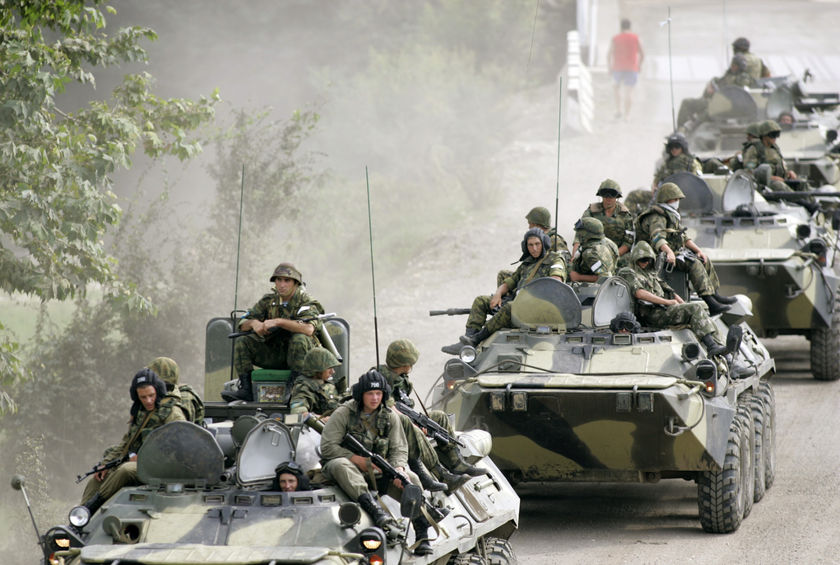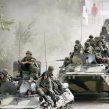
The Russia-Georgia Conflict as Analyzed by the Center of Analysis of Strategies and Technologies in Moscow
Publication: Eurasia Daily Monitor Volume: 7 Issue: 16
By:

Part Two
The long-term military implications of the Russian-Georgian war are addressed by Viacheslav Tseluiko. He warns that the popular conclusions regarding the weakness of the Georgian army during the conflict should not be taken as decisive evidence of the inability of Georgian forces to counter Russian intervention. The Georgians seem to have learned some valuable lessons from their defeat. He devotes considerable attention to the further transformation of the Georgian armed forces in the wake of the conflict and sees increased capabilities achieved over the course of the past year.
The Georgian government plans to undertake no large-scale deployment of forces outside of the country, except for a token force for operations with ISAF in Afghanistan. Given the poor performance of the Georgian air force and the observed weaknesses in the air defense system, priority has been given to improving air defense systems through acquisitions from Ukraine, Poland, and Israel. The Georgian navy, which suffered serious losses during the war, was abolished in October 2008, and its remaining cutters transferred to the shore defense forces of the army.
Tseluiko sees as a major reason for Georgia’s defeat in August 2008 as the lack of preparation of its senior commanders, battalion and above, to conduct combat operations, and notes that the army has instituted a short course for the professional preparation of those officers to conduct combined arms combat. The bottom line of this assessment is that one year after the war the Georgian military, except for the navy, is actually stronger than it was in August 2008. This increased strength does not mean an enhanced capacity for a military coup de main against Abkhazia and South Ossetia. Mobilizing significant a reserve force in a pre-conflict situation is hard to conceal because of the actions involved (call-up, force assembly, and deployment). Reserve mobilization is one of the most overt manifestations of imminent threat, which signal the Georgian government’s perception of an imminent threat from Russian deployments and Tbilisi’s intent to invite diplomatic intervention to forestall hostilities. This logic depends upon the posture that Russian forces assume in the regions bordering Georgia.
In comparison, Tseluiko sees the Russian army as weaker one year after the Georgian War. Here he cites numbers of men under arms, and he calls attention to the decline in forces in the North-Caucasian Military District, which carried the primary burden of the war. These lower numbers take on significance when Tseluiko raises the treat of increased violence across the North Caucasus, not from an attack by Georgian regular forces but the appearance of armed bands, which could use Georgian territory as a base of operations, re-supply and reconstitution. This consideration speaks more to the increasing instability across the region than to a direct and immediate Georgian threat. Other reforms, however, reveal decreased capabilities in the North Caucasus: the cut in the number of attack aircraft assigned to the North Caucasian Military District by half and the reduction in the size of the Russian Military Transport Aviation, which has reduced the capacity of Russian airborne forces to deploy rapidly to the region.
In dealing with the Russian lessons learned from the Russian-Georgian War, Tseluiko points towards military reforms that are betting on qualitative improvements to compensate for smaller forces. Serdyukov has made that the clear direction of defense reform in the aftermath of the war. The author does not mention the restructuring of the armed forces on a brigade model, the plans for the acquisition of advanced technology nor the introduction of a network-centric form of warfare. His focus is on current combat capabilities in theater, and his bottom line is that the reforms have not yet weakened, but also have not strengthened Russian military presence in the region.
Turning to the actual situation on the ground, Tseluiko examines the changes in Abkhazia and South Ossetia and assesses their implications for organizing military operations. Turning to regional implications, he provides as assessment of the impact of the Russia-Georgia war on Azeri-Armenian conflict over Karabakh, and leaves the impression that Russian troop presence in Armenia is primarily directed at the intimidation of Georgia and could be undermined by a shift in the military balance between Azerbaijan and Armenia, which leads him to call for a major rearming of Armenia and increased Russian troop presence there.
Given the extent of the initial attention paid to Russian air losses in the war, Lavrov’s chapter on that topic should attract great attention. Lavrov cites those losses as one of the most unexpected outcomes of the conflict for observers. The Russian defense ministry reported the loss of four aircraft (three SU-25 ground attack aircraft s and one Tu-22M3 strategic bomber). Saakashvili announce that Georgian forces had shot down 22 Russian aircraft. Two additional Su-24 fighter-bombers were never announced as combat losses by official Russian sources, but were verified by reports of downed aircraft. The confusion about Russian air losses follows from the usual fog and friction associated with combat. In this case, one of the contributing factors in this conflict was instances of loss by “friendly fire.” The first Russian Su-25 was shot down over South Ossetia late on August 8 by ground fire from South Ossetian forces. This missile attack was broadcast by Russian national television and reported as the shooting down of a Georgian Su-25. The first Russian aircraft lost to Georgian fire came on the morning of August 9 when the Tu-23M3 returning from a bombing strike came down from 12,000 meter altitude to 4,000 meters and was attacked by Georgian air defense missiles about 50 km north-west of Gori. The aircraft lost some of its major systems. Only the pilot and co-pilot ejected from the aircraft, but only the co-pilot survived the ejection and was captured by the Georgians. The bodies of the other two crewmen were recovered from the crash site later. The second success of Georgian air defense forces came later that morning when a Su-24 was shot down by an anti-aircraft missile south of Tskhinvali. Several cell phone cameras caught the attack and destruction of the aircraft. Both the pilot and co-pilot ejected from the aircraft, but the co-pilot’s parachute was damaged by fire from the aircraft and he died on impact. The pilot, who was wounded, was captured. About 1030 the same morning another Su-25 was hit by a SAM south of Tskhinvali during a strafing run and lost an engine. The pilot decided to return to base but when crossing the city of Tskhinvali he was hit by another SAM and lost his second engine. He was able to glide into Russian controlled territory, before ejecting and was recovered by a Russian search and rescue helicopter. It is still unclear who fired the second SAM at the aircraft. At that time, South Ossetian air defenders claimed to have shot down a Georgian Su-25 in the same region. Moreover, Georgian sources confirm that there were no Georgian Su-25 combat missions on that day, raising at least the possibility that the second Su-25 was also a victim of friendly fire. Later that day another Su-25 was shot down in the area of Gufta Bridge. At the time Russian air defense forces claimed to have shot down a Georgian Su-25 in the same area. The pilot of the lost Russian aircraft did not report any damage nor did he attempt to eject for the aircraft. Lavrov, on the basis of evidence of later inspection of the crashed aircraft by Russian officials concluded that the aircraft was probably shot down by a Russian ZSU-23 in a case of failure of the fighter’s indicator “friend or foe” system. The final aircraft lost in combat was a Su-24, which was shot down by friendly forces while it was escorting a Russian column on the Tskhinvali-Gori highway, when it was hit by a Russian SAM. The crew ejected and was recovered by a search and rescue helicopter. Lavrov’s analysis makes a compelling case on two points: Russian air losses were concentrated in the period 8-9 August, with August 9 witnessing the heaviest losses of four aircraft, and that of the six aircraft lost, over half were the result of friendly fire. While this analysis reduces the effectiveness of the Georgian air defense system, it raises serious questions about the ability of Russian air control systems to manage the airspace of the battlefield. Lavrov goes as far as to suggest that the Russian air and ground forces actually fought two different wars without much knowledge of what was going on in the other sphere. This reveals the gap that exists between Russian forces’ capabilities and the proclaimed desire to conduct network-centric warfare as part of “new look” reforms.
The book concludes with two chapters by Lavrov. The first addresses in detail Georgian losses in men and equipment during the war. While the losses were significant, given the forces committed, especially in the heavy fighting around Tskhinvali, the impact of the losses was multiplied by the failure of the Georgian government to provide its troops and population with an accurate account of the fighting, which fed rumors of disaster. Defeat at Tskhinvali and the withdrawal became a rout, because of mounting fear of Russian air power and the rumors about the scale and speed of the Russian advance. Panic infected both the leadership of the government and soldiers and soon spread to the civilian population.
In the final chapter Lavrov addresses the basing of Russian combat forces in Abkhazia and South Ossetia after Moscow formally recognized their independence. The account provides a good picture of the difficulties faced by Russian units rebasing to the republics. Much of the effort was devoted to the expansion of existing military facilities, the establishment of new ones, and the pre-deployment of heavy weapons to those bases with the notion of sending in troops to man them in a crisis situation. These efforts included the development of a naval base in Abkhazia and the deployment of naval units belonging to the Russian border patrol. Air fields were also improved, including those supporting attack helicopters. Russian engineers devoted significant resources to the improvement of roads in South Ossetia in attempt to increase their all-weather utility. Lavrov emphasizes that these efforts undermined the combat effectiveness of the forces. Field service living conditions impacted on morale and brought increased desertions among the deployed units. Many completing their terms of contract service did not stay in the military because of disputes over deployment bonuses and because of difficult living conditions. Lavrov notes that in the major summer exercise, Kavkaz 2009, few Russian forces deployed in Abkhazia and South Ossetia participated and their part was limited to command-post staff exercises and the exercise did not involve the forces of the Republics of Abkhazia and South Ossetia. Current Russian forces in the Republics could not defeat a major Georgian offensive, but they could delay its advance while forces from the North Caucasus Military District and beyond deployed. Within the District Russian forces have been given a high priority for both brigade restructuring and the acquisition of new weapons. Both moves increase their combat capabilities and preparedness. Lavrov argues that these moves have reduced the risk of military provocations from Georgia.
Those interested in contemporary military affairs, military theory, and the security situation in the Caucasus will find this volume of value.




